A First Foray into Bike Touring
Tagged: bike opinion diy projectLast summer I built a bike and left town with it.
This is a continuation of the lineage of this This Bike. I rode it around as a fixed gear for a year or so before deciding it wasn’t for me. It was fun to ride, but my knees hurt. Every ride was exhausting. I found myself avoiding the fixed gear because riding other bikes was more fun and relaxing. Eventually, I decided to flip the hub around and ride it as a single speed. And then the day come when I decided it would make more sense to just give it gears and build it back into a road bike.
Sidenote: I watched Lucas Brunelle’s Line of Sight, which is a fantastic documentary about fixed gear bike couriers. One of the couriers interviewed said something to the effect of “I see my bike in my dreams. It never gets tired, but I do, and it doesn’t matter if I’m tired, it makes me keep going.” And that didn’t make sense to me until I spent a week riding the fixie as my main mode of transport. The bike drags you along with it, even if you’d rather sit back or go slow. There’s no rest in the saddle of a fixed gear bike, not uphill, not on the flat, and especially not downhill.
So I gave away my fixie wheelset and drivetrain and started over. I had been slowly accumulating some half-decent road bike parts with no real plan, so I figured this would be the project to put them to use. This would be a proper drop-bar bike, ideally with bar-end friction shifters, 700C wheels, dual-pivot brakes, and a more modern drivetrain components. Moreover, it would give some new life to the beautiful steel frame that my mom found at a junk exchange, which is also a plus. I’m a sentimental person, and this fame has earned quite a lot of sentimental value. It deserves a name, but I still haven’t thought of one that fits yet.
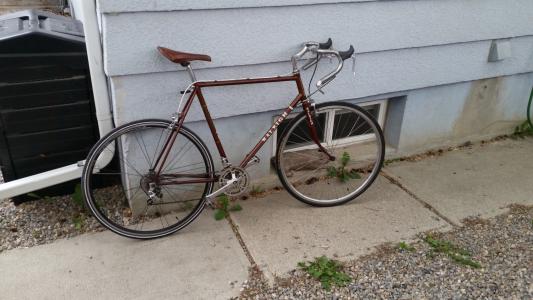
And so, the slow conversion process began.
Road Bike Conversion
The process of converting this to a functional bike was a long and iterative one, with many test rides intermittent. Parts were sometimes hard to find and trickled in after many weeks of looking. I’ll speak to anything that was a pain point below.
The Brakes
The first issue I ran into was that I wanted good modern dual-pivot road bike brakes. Newer brakes typically assume recessed mounting on the frame, but obviously that wasn’t the case for this old frame. This was fixed easily enough with various nuts and spacers.
The more challenging issue was to do with the wheel size. Most newer road bikes that use caliper brakes have thin tires and little clearance with the frame. This bike, being as old as it is, is designed for 27" wheels (ie 630mm inner bead diameter). I have converted it to use 700C wheels (622mm inner bead diameter).
As such, almost no modern road brake calipers actually even reach the rims.
I managed to find a pair of extra-long-each calipers. They aren’t as strong as the shorter-reach calipers, and so they feel gummy and less responsive, but they work okay!
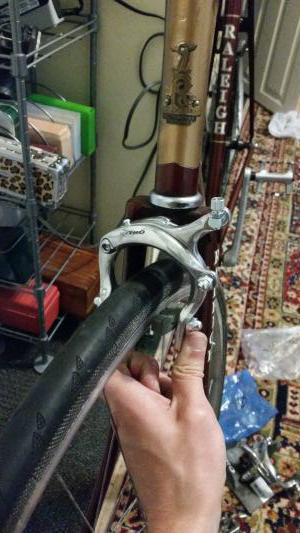
Hanging the Rear Derailleur
Another issue with vintage bikes is that they have horizontal dropouts. Derailleurs from this era are mounted claw-style, without a derailleur hanger. For the first iteration of making this a functional bike, I just grabbed a vintage derailleur and stuck it on, but eventually I was able to find claw-style derailleur hangers that could fit modern derailleurs. I’d highly recommend these - in some ways they’re more convenient than modern derailleur hangers, due to their near-universal compatibility.

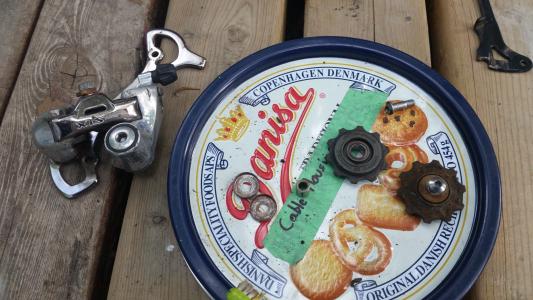
The Drivetrain
For the actual drivetrain, I used old (90s - 2000s era) mountain bike drivetrain parts. This is mostly due to the fact that I find the gear range more agreeable. Road bike parts tend to have a LOT of gears with very little difference to keep your optimal cadence. Mountain bike parts tend to have wider gear ranges and lower gearing overall. But a significant factor is the prevalence of mountain bikes where I live. Mountain bike parts are good, plentiful, easily accessible, and cheap.
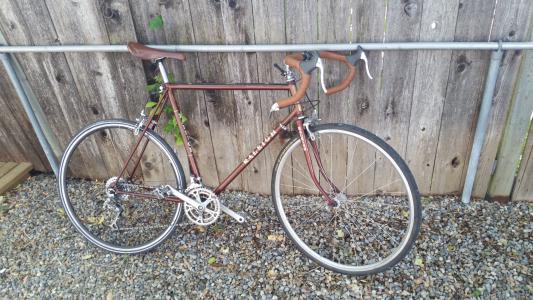
The rest of the parts were scavenged from bikes that I had torn down myself, or from parts bins at the bike co-op. Some were quite nice! And I was happy to find a home for them on this new project.
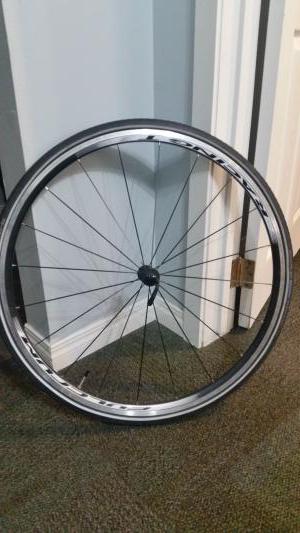
Another thing I didn’t really anticipate was an issue with the front derailleur. I had an old one from a vintage bike that seemed like a good fit. Since I was using friction shifting rather than indexed, I didn’t think it would matter that it was designed for a 2x front chainring.
Unsurprisingly, I was completely wrong. It turns out that a 3x drivetrain requires a 3x derailleur. A 2x derailleur can afford to have straight sides, as it just needs one point of contact to bump the chain left and right.
The extra gear range in a 3x setup needs a specially shaped inner cage plate, to ensure you have the right contact point with the chain while shifting. Sheldon Brown’s site goes into more detail here

Up until this point, I was using one single bar-end friction shifter, and a mismatched stem-mounted friction shifter. Shifting was awkward, and I had been looking all over for a half-decent set of bar-end shifters. These were surprisingly hard to find! There were none at my local bike co-op, and buying new ones would have easily cost more than everything else on the bike.
The unfortunate truth about finding specific components for a reasonable price is that you sort of have to pull them off an existing bike.
In the end I got very lucky. Trawling through back alleys as usual, I found a very old Norco-made road bike with bar-end shifters in good condition.
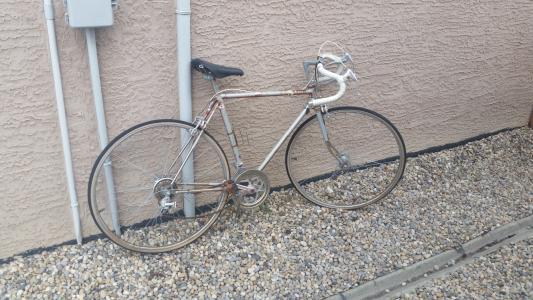
I was ecstatic. They were exactly what I needed. Friction shifters with an easy way to mount on the end of drop bars. Such a simple thing and yet surprisingly hard to find.
I also noticed that, unlike modern bar-end shifters, the left and right shifter are exactly the same. They also make a very satisfying ratcheting noise when the cable is pulled. A vintage bike should have quirky little joys like this.
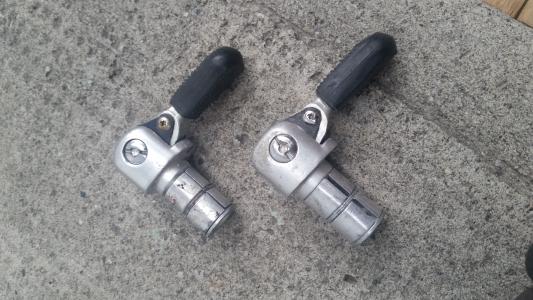
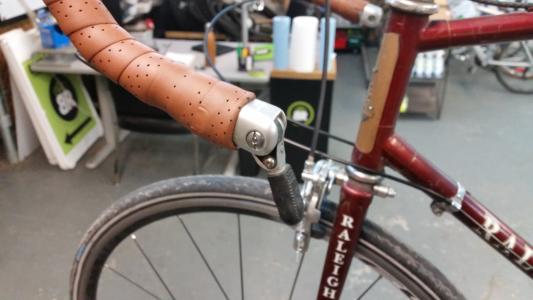
Around this time I did a charity ride. I tuned and lubed the bike, took the rack off, and rode 75km at an event. I won’t give any more details for the sake of privacy, but it was a fun time! And I raised about $500 in pledges to support programs and resources for cancer patients.
With that, I deemed this build a success! It was good enough to finish a larger ride alongside much more fancy and expensive bikes.
The First Tour
The last thing I wanted to try before the summer ended was to leave town by bicycle and try some light touring.
The decision to go out of town and spend the night was one of impulse and opportunity. My partner was out of town, I had a free weekend, I was enjoying doing work on my bikes, the weather was nice, et cetera. It seemed like a fun thing to just get out there and try.
I decided to start easy. I rode to a neighbouring town that was only about 30-some kilometers away. If things went wrong, I could probably phone someone to pick me up. If my accommodations fell through, I might even have enough time to cycle home before dark. I left the house at the late hour of 10am (I had only just decided the night before that I would give it a shot, so it took some time in the morning to make decisions and get ready.)
I took paved, less-traveled township and range roads where possible. I loaded up, wrote some directions in a notebook, took the LRT to the end of the line, and started riding.

I’m a huge fan of the place where I live. It’s all prairie with a big sky and a lot of farmland. As long as you stay off the main highways, it’s also very quiet and serene. Frogs croaking in sloughs, sun-drenched fields with hay in roundbales, old rusting farm equipment used as end-of-driveway decoration, that sort of thing. I think it’s beautiful, and rolling along at bicycle-pace through it gave me a new perspective on it.
The vehicles on this rural road were also very courteous. A lot of it was pickups towing farming equipment and supplies. They honked from a ways off and gave me ample time to get out of their way, waving at me as they rolled by. The vibe was fantastic.
Some of the medium-busy roads were a bit less serene, but there was enough of a shoulder that they weren’t scary.
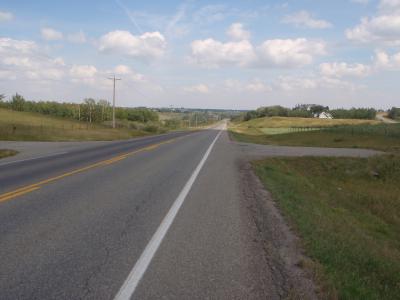
Once I was on the road, the only real mechanical issue I encountered was to do with my rear rack. It was a standard aluminum bike rack, and fit fairly narrowly on the frame. This is probably because, as I may have mentioned in my previous post on this bike, the rear dropouts were designed for a 126mm OLD. The frame had been stretched to 130mm to accommodate newer rear wheels.
As a result, the straps that secured my rear pannier to the rack occasionally flapped against the spokes. this was easily fixed on the road with a bit of electrical tape.

People joke about how traversing the prairies is a boring experience - it’s just flat. They say that if your dog runs away, it will take three days before it’s out of sight. But as with any ecosystem, as well as any place touched by human habitation, there are points of interest all around. You just have to take the time to find them.
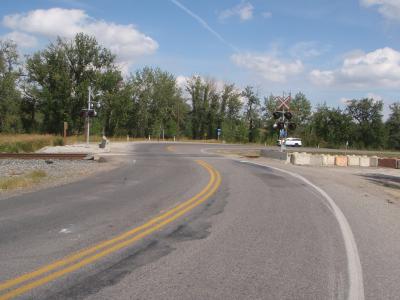
One of the sadder things I saw was a ghost motorcycle. It was after a very short and very busy connecting road, so I was a bit on edge after mingling with high speed traffic. This was someone’s memorial.

If you don’t know what a ghost bike is, you can read about them here.
It probably goes without saying, but after seeing this on the side of the road where I was currently traveling, I was quite on edge. I had been a little anxious before this about riding on the shoulder of highways with cars next to me moving at upwards of 100km/h, and after this I was very deliberate and careful. There was definitely risk to what I was doing. Maybe not a ton of risk, but risk all the same.
Maybe I was mitigating that risk by riding in the day time, highly visible, and picking my route carefully. But nothing can eliminate it entirely.
I stayed the night in a motel in the next town over. I had booked it ahead of time, though I’m not sure that was necessary. Once I was checked in, I dropped off the bulk of my stuff and rode around town. It was a small town, easy to traverse end-to-end. I checked out an art market, a museum, an outdoor musical performance, and the public library. I also got some amazing lebanese food, which really hit the spot after a long ride.
When it got dark, I retired to my room and took a long bath. At that time I was living in a basement suite with only a shower stall, so I was really missing the ability to take a bath.
Before bed, I popped open my laptop and planned the next day’s route. I decided I’d keep going, and loop around to some other small towns before heading back to my city.
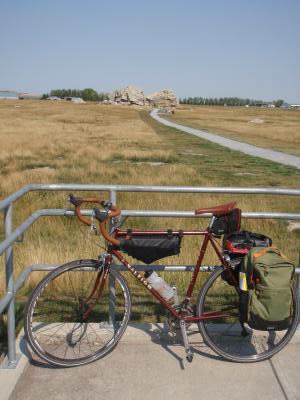
The next day, I was back on the road. I checked out the glacial erratic nearby. I rode on the bike and pedestrian trail that was recently built to connect two neighboring cities. (The Friendship Trail, it was called.) And I rode a lot of township and range roads.
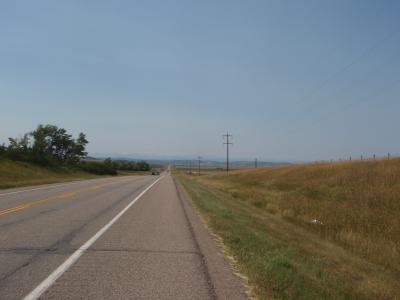
Before taking this trip, I thought I had an appreciation for the place where I live. Now that appreciation has doubled. I love the flat expanse. I love the fields. I love the sense of scale and parallax as you slowly roll by a hillside covered in roundbales.

Once you got off the main thoroughfare, the roads were pretty rough. I initially thought they were gravel roads, but I was mistaken. They were simply unkempt - weathered and covered in gravel and dirt and other bits of detritus. It made me realize how much upkeep the government puts into our city roads and major highways. This is what they look like if neglected.
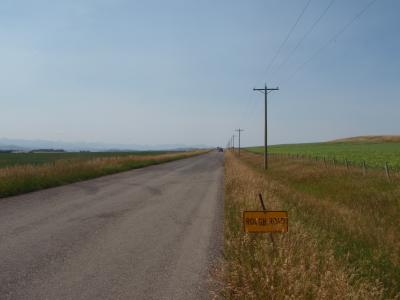
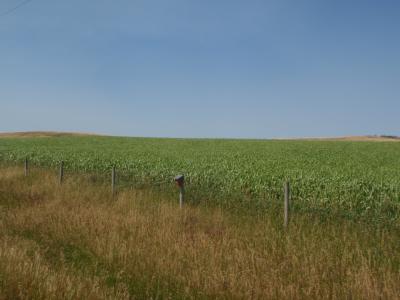

My tour ended up getting cut short, though. I got a call from my family, who had gone on an excursion to a nearby campsite / picnic area, and they asked if I wanted a pickup. I said sure, and we went to dinner before heading back into town.
I don’t regret it, per se, but I’d like to try again and go the full distance by bicycle. I bet after a long tour the sense of accomplishment is palpable, and the satisfaction in returning home and kicking back must be immense.
Packing and Gear
I love snooping other peoples’ gear. I like seeing organized toolboxes, camping setups, luggage packing tips, every day carry spreads, et cetera. It’s a very enticing thing - you get a tiny window into their lives and approaches. You see how they solve the problems you’re having, as well as how they’re handling ones you don’t have or haven’t thought of. And, of course, you get to see all their toys. Maybe you can even do some copycat shopping. (That last one is dangerous. Be careful of advertisers.)
So naturally, I’m going to share the little touring setup I came up with for this trip. Here are all my bags, taken off the bike at the end of the tour.
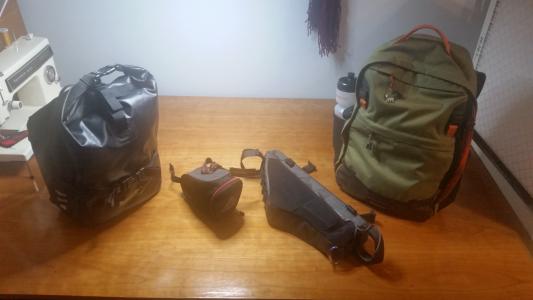
I took four bags in total. Two rear pannier bags, one small frame bag, and a seat wedge pack. I probably over packed, if I’m being honest.
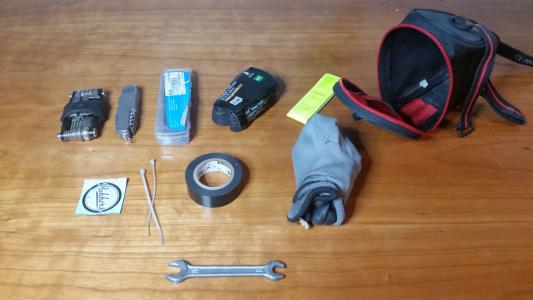
I keep anything bike maintenance related in a seat wedge pack. This includes a multitool, a patch kit, a swiss army knife, a spare tube, some zip ties, a spanner, electrical tape, and some gloves. I have a small bicycle pump that almost fits in this pack. Can’t have everything, I suppose.
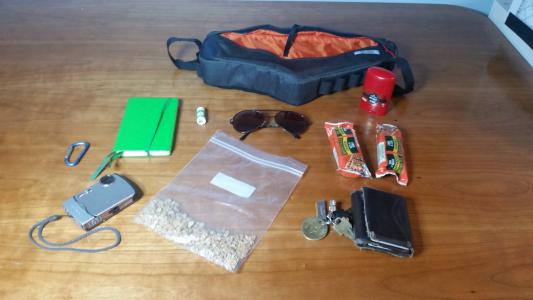
I used my frame bag to hold anything that I might need to use on the trip, because it can be accessed without dismounting the bicycle. For the most part, that meant snacks. When I set out, I had berries, granola, snack bars, fruit, chocolate, and more. I spent the entire trip snacking. One should eat before they are hungry, and drink before they are thirsty when doing something very active.
Also included are some utility items like lip balm, a small point and shoot camera, a notebook, sunglasses, and deodorant. When I was on the bike I also kept my wallet and keys in here. My phone went in a side pocket where I could easily grab it.

This roll-top, completely waterproof PVC side pannier was for overnight stuff that I most likely wouldn’t need during the ride. This included clothes and toiletries. I had socks and underwear in a smaller bag inside, to make extra sure they stayed dry. I didn’t end up opening this until later that evening when I was at the motel.

And lastly, I had my big pannier, with everything else. This one was very overpacked, no question about it.
It included spare water (you can never have too much), a cable lock for the front wheel, sunscreen, a small medical kit with bandages, tweezers, disinfectant, and painkillers, a laptop, pens and pencils, a journal, hand cream, maps of the area, a compact bike pump, bandanas, a mess kit, earphones, wet wipes, bone conduction headphones (These are wearable when riding, as you can still hear your surroundings), a lighter, a tape measure, extra food, lights for riding at night, charging adapters and cables, spare change, and an e-reader.
A lot of this stuff never even got touched on the trip. But I’ll repeat the old adage - it’s better to have it and not need it than to need it and not have it. Besides, I wasn’t regretting carrying too much weight while I was on the road, so I probably packed well within reasonable parameters.
In addition to what was in the bags, I had a water bottle, ad helmet, and a hiplok, which is a bike lock that you wear as a belt when riding. The main advantage of this for me is that I’m less likely to forget it.
Further Improvements & Closing thoughts
After the tour, I kept steadily making improvements to the bike. The rack I used for the tour was too narrow to comfortably use my usual pannier, so I ended up picking up quite a nice one on clearance and installing that. I found some mounting clamps and used them to install a second bottle cage. And I eventually found a nicer Shimano Acera rear derailluer, and replaced the 90s Deore one with that.
The final finishing touch came while I was doing a volunteer shift at the local bike co-op. Someone donated their old Raleigh, and it came with an official (if obsolete) license plate, from the brief period of time where my city required bicycles to be registered and licensed.
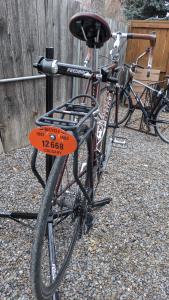
Sidenote: Every single bicycle registration program in the world has failed. This is truly a relic of a failed experiment. But it’s technically a reflector, and it’s a conversation starter!
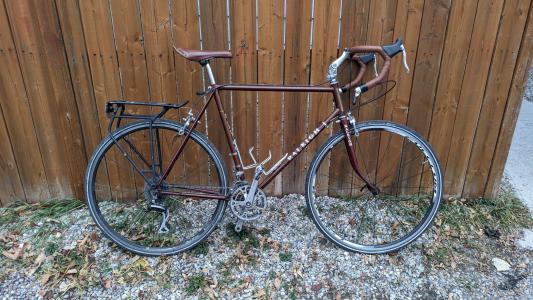
I’ve let this post languish for a long time, but now I have a years’ worth of hindsight. I’ve been riding this bike all summer, almost exclusively. It’s my commuter, grocery bike, and long-haul road bike.It’s the definition of a daily driver. It’s probably not the best choice for this purpose, what with its relatively weak brakes and friction shifting. But I think a big part of what motivates me is aesthetics. I think this thing is absolutely beautiful, and riding it around sparks a lot of joy.
Therefore, it gets ridden, and therefore it’s a more useful bike. Nobody yells “Nice Bike!” at me when I pass them on my (admittedly much newer and fancier) black Rocky Mountain commuter, but they do with this thing. Mostly old guys, of course. But they’re old guys with good vibes.
The last thing this bike needed was a name. I couldn’t for the life of me come up with one that fit, and so it remained nameless for several years. But one day I brought that up with my co-volunteer, and she suggested the name “Earnest.” It immediately seemed like the correct choice. This bike is painfully genuine. It embodies the virtue. Not to mention, Ernest is a fitting name for an old guy. And this bike is certainly an old guy.
So there you go. I toured, for the first time, in earnest. And also on Earnest.